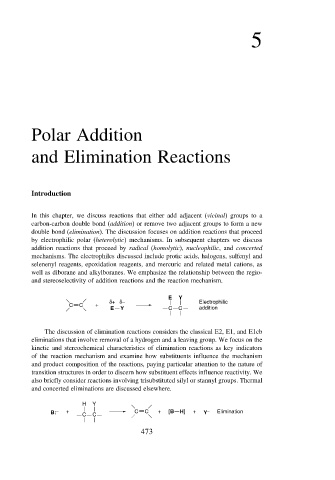Page 492 - Advanced Organic Chemistry Part A - Structure and Mechanisms, 5th ed (2007) - Carey _ Sundberg
P. 492
5
Polar Addition
and Elimination Reactions
Introduction
In this chapter, we discuss reactions that either add adjacent (vicinal) groups to a
carbon-carbon double bond (addition) or remove two adjacent groups to form a new
double bond (elimination). The discussion focuses on addition reactions that proceed
by electrophilic polar (heterolytic) mechanisms. In subsequent chapters we discuss
addition reactions that proceed by radical (homolytic), nucleophilic, and concerted
mechanisms. The electrophiles discussed include protic acids, halogens, sulfenyl and
selenenyl reagents, epoxidation reagents, and mercuric and related metal cations, as
well as diborane and alkylboranes. We emphasize the relationship between the regio-
and stereoselectivity of addition reactions and the reaction mechanism.
E Y
δ+ δ– Electrophilic
C C +
E Y C C addition
The discussion of elimination reactions considers the classical E2, E1, and E1cb
eliminations that involve removal of a hydrogen and a leaving group. We focus on the
kinetic and stereochemical characteristics of elimination reactions as key indicators
of the reaction mechanism and examine how substituents influence the mechanism
and product composition of the reactions, paying particular attention to the nature of
transition structures in order to discern how substituent effects influence reactivity. We
also briefly consider reactions involving trisubstituted silyl or stannyl groups. Thermal
and concerted eliminations are discussed elsewhere.
H Y
B: – + C C + [B H] + Y – Elimination
C C
473

